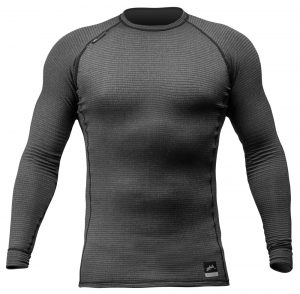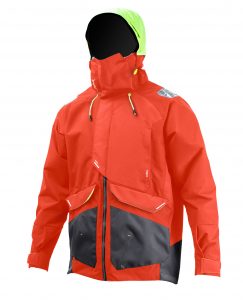“There’s no such thing as bad weather, only bad clothing” as the saying goes. Colder weather should not keep us from having fun on the water. In fact, it’s the crisp winter days that can be some of the most memorable!
Whether summer or winter, the wrong type of clothing or out of date fabrics can spoil a day for all on the water activities, especially for the novice boater. Fortunately, we now have the option to wear lighter weight, less restrictive, highly breathable garments that will keep you warm and dry, all day.
Suffering from the cold or extreme heat also detracts from our peak performance or simply enjoying the day on the water. Genetically, our levels of tolerance to cold climates are unique to each person. Yet getting cold or wet is preventable with a good layering system, so plan the clothing you’ll take out with you each time you go boating.
Layering is all about wearing the right combination of garments for the conditions. What it’s not is just a bunch of clothing that we peel off as the day goes on. For boating and all outdoor activities, it’s more of an exact science.
These days base layers are more than a thermal garment to keep you warm. The base layers’ true function is to keep the surface of your skin dry by moving moisture away from the skin surface. This is known as ‘wicking’.
 A good base layer keeps you warm in cold conditions, and is as important for staying cool on hot days especially when wearing waterproof breathable outer garments.
A good base layer keeps you warm in cold conditions, and is as important for staying cool on hot days especially when wearing waterproof breathable outer garments.
With just moderate exertion, our bodies naturally lose over a pint of moisture vapour in one hour. This is the body’s own natural cooling system. To prevent discomfort, we need to avoid this moisture being absorbed by fabrics next to the skin. Instead, the moisture needs to be able to evaporate or wick away to the next layer so the skin remains dry.
If you are used to wearing cotton Tees, jeans then beware! Cotton clothing can absorb moisture up to 20% of its weight. Damp fabric and moist air transfers heat away from the body twenty times faster than dry fabric. If you are wearing cotton clothing next to the skin it will absorb the moisture and suck the heat out of your body, leaving you feeling cold, clammy, and leading to early tiredness and fatigue.
Base layers are normally a long sleeved top and leggings. On very cold fresh days base layer socks, glove liners and headwear can add another layer of cosiness. The head and feet are particularly important areas of the body to protect and control moisture management.
Mid layers are worn over the base layer for insulation, and under waterproof garments. They work by keeping dry warmed air trapped close to the body. With your skin temperature at around 87 degrees, the body heats the air next to skin.
The trapped dry air acts like double glazing in a house and keeps you warm. The garment must be highly breathable too, to allow moisture to pass through, a process known as moisture vapor transfer. Otherwise, there’s a risk of moisture building up between the base layer and the mid-layer causing dampness and chilling.
Typical mid layer garments are a:
Be sure the materials are non-absorbing too, and shed water, a feature that’s sometimes referred to as hydrophobic. Water droplets literally shed off the fabric.
Some mid-layers also double up as windproof and / or a water shedding or waterproof layer.
These can make excellent and versatile mid-layer garments, for on and off the boat! They mean you can delay the need to put waterproofs on until things get really cold or wet on board. Make sure though that the windproof or waterproof layer is also highly breathable to enable MVT to continuously occur.
The outer layer is where the real protection against the elements takes place, especially if it’s wet, windy or cold. Choose a garment that is completely waterproof and windproof. Most modern-day fabrics are breathable to greater or lesser degrees.
 If you are planning to be relatively active on board or in your waterproofs for a long time, a good quality breathable fabric is worth the investment. The breathable outer layer works to move warm moist air from the mid-layer to the outside, thus allowing the moist air that’s built up inside the garment to escape.
If you are planning to be relatively active on board or in your waterproofs for a long time, a good quality breathable fabric is worth the investment. The breathable outer layer works to move warm moist air from the mid-layer to the outside, thus allowing the moist air that’s built up inside the garment to escape.
The higher the level of breathability, the more comfortable you will be. You also want a fabric that is highly durable against wear, and capable of keeping you dry all day in the worst conditions and pouring rain.
Your outer layer needs to be well fitted, yet do not wear it too snug or tight fitting. Some manufacturers, such as Zhik, now even have built in stretch into their coastal and offshore fabrics to enable the garment to ‘give’ during movement around the boat.
The principle purpose for the outer layer jacket and salopette trousers is to stop water getting in and also to contain the warm air within the mid layer from escaping. This is often looked as part of the layering principle for keeping warm. Popping waterproofs on even if it’s not wet can make a significant different to maintaining body temperature, as they protect from windchill too.
Always choose a jacket with an an effective, and well-designed hood and collar system, protective flaps over the front zip and adjustable inner cuffs.
The latest fabrics are lighter, more flexible and also more durable than ever before. You cannot gauge these fabrics by touch and feel as technology has advanced and the water proof garments have become more breathable, more durable (hard wearing) yet also softer and lighter. This allows greater freedom of movement which is less tiring when worn for extended periods, enhancing the on the water activity and experience.
Keep the extremities warm
You lose a lot of heat from your head and wrists. Always have a good warm hat or hood available and fleece or insulated gloves for winter boating. Warm socks inside a good pair of seaboots is also advisable. Leather boots with thick soles are often warmer than rubber ones.